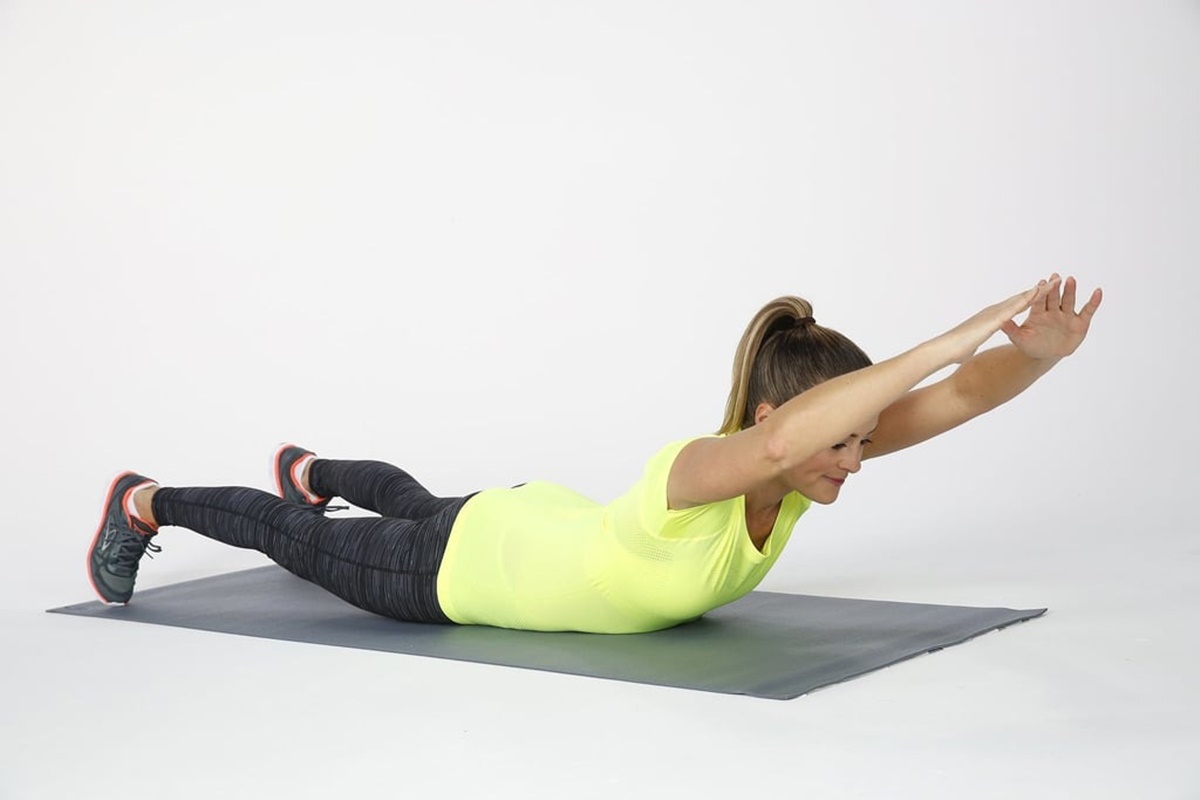

Featured
How To Workout Your Neck
Modified: January 2, 2024
Looking to strengthen your neck muscles? Discover effective techniques and exercises in our featured guide on how to work out your neck.
Introduction
Welcome to the world of neck workouts! While many fitness enthusiasts focus on developing their chest, arms, and abs, the neck often gets overlooked. However, neglecting the neck can lead to a range of issues, including poor posture, muscle imbalances, and even neck pain. That’s why it’s crucial to incorporate neck exercises into your fitness routine.
Working out your neck not only strengthens the muscles but also improves flexibility, stability, and overall functionality. Whether you’re an athlete looking to enhance performance or someone seeking relief from neck discomfort, dedicating time to neck workouts can yield significant benefits.
Before diving into neck exercises, it’s important to understand the precautions and guidelines to ensure safety and effectiveness. In this article, we will explore a variety of neck stretches and strengthening exercises, along with proper form and technique to maximize the results of your workouts.
Let’s get started on this journey to a stronger, healthier neck!
Why it’s important to workout your neck
When it comes to fitness, it’s easy to focus on the big muscle groups like the chest, arms, and legs. However, the neck plays a crucial role in our overall well-being and should not be ignored. Here are several reasons why it’s important to incorporate neck workouts into your fitness routine:
- Improved posture: A strong neck helps maintain proper spinal alignment, which in turn promotes good posture. Poor posture can lead to muscle imbalances, back pain, and even headaches. By strengthening the neck muscles, you can alleviate these issues and achieve better posture.
- Reduced neck pain: Many people experience neck pain due to excessive sitting, poor ergonomics, or muscle imbalances. Neck exercises can help alleviate tension and strengthen the muscles that support the neck, reducing pain and stiffness.
- Enhanced athletic performance: Athletes in various sports, such as football, wrestling, or combat sports, require strong neck muscles to withstand impacts and resist forces that can cause injury. Training the neck can improve overall neck strength and stability, reducing the risk of injury during athletic activities.
- Injury prevention: A strong neck can help prevent injuries caused by sudden movements or impacts. It acts as a shock absorber, reducing the strain on other structures of the spine, such as the discs and vertebral bodies.
- Improved range of motion: Regular neck exercises can improve flexibility and range of motion in the neck, allowing for better movement and reduced stiffness.
By working out your neck, you not only enhance its strength but also improve its function and resilience. It’s an essential part of your overall fitness and well-being.
Precautions before starting neck exercises
Prior to starting any neck exercises, it is important to take certain precautions to ensure your safety and prevent any potential injuries. Here are some important considerations to keep in mind:
- Consult with a healthcare professional: If you have any pre-existing neck conditions or injuries, or if you’re unsure about starting neck exercises, it is recommended to consult with a healthcare professional or a qualified fitness trainer. They can assess your specific situation and provide personalized guidance.
- Warm up: Just like with any other exercise, it is important to warm up your neck muscles before starting the workout. This can be done with simple neck rotations, gentle stretches, and range of motion exercises. A warm-up increases blood flow to the muscles and prepares them for the upcoming workout, reducing the risk of strains or injuries.
- Start with gentle exercises: If you’re new to neck workouts, it’s important to start with gentle exercises and gradually increase the intensity. This allows your neck muscles to gradually adapt and reduces the risk of overexertion or strain.
- Pay attention to your body: Listen to your body’s signals during the exercises. If you experience sharp or prolonged pain, dizziness, or any discomfort that feels unusual, stop the exercise immediately and seek medical advice if needed.
- Use proper form and technique: Proper form and technique are crucial to derive maximum benefits from neck exercises and prevent injuries. Make sure to maintain a neutral spine, avoid putting excessive strain on your neck, and engage the targeted muscles effectively.
- Breathe and relax: It’s important to breathe properly and relax your neck muscles during the exercises. Avoid tensing up or holding your breath, as this can lead to increased muscle tension and reduced effectiveness.
- Progress gradually: As your neck muscles become stronger and more conditioned, you can gradually increase the intensity and duration of your exercises. However, always progress at a pace that feels comfortable and within your own limits.
By taking these precautions, you can minimize the risk of injury and ensure a safe and effective neck workout routine.
Neck stretches
Neck stretches are a great way to warm up the neck muscles, improve flexibility, and relieve tension. Here are a few effective neck stretches that you can incorporate into your routine:
- Neck tilts: Sit or stand with a straight back. Gently tilt your head to one side, bringing your ear towards your shoulder. Hold the stretch for 15-30 seconds and then repeat on the other side. You should feel a gentle stretch along the side of your neck. Avoid any excessive or painful movements.
- Neck rotations: In a seated or standing position, slowly rotate your head to one side, as if you are trying to look over your shoulder. Hold the position for 15-30 seconds and then repeat on the opposite side. This stretch targets the muscles at the back of the neck and improves range of motion.
- Chin tucks: Begin by sitting or standing with your shoulders relaxed. Gently tuck your chin towards your chest while keeping your back straight. You should feel a stretch along the back of your neck. Hold for 15-30 seconds and repeat several times.
- Upper trapezius stretch: Sit or stand with your shoulders relaxed. Slowly tilt your head to the side, bringing your ear towards your shoulder while simultaneously reaching your opposite arm overhead and gently placing your hand on the side of your head. Apply a gentle downward pressure to deepen the stretch. Hold for 15-30 seconds and repeat on the other side.
- Levator scapulae stretch: In a seated or standing position, gently tilt your head to one side, bringing your ear towards your shoulder. Place your hand on the opposite side of your head and apply gentle pressure to the side of your head, while simultaneously turning your chin slightly towards the floor. You should feel a stretch in the back of your neck. Hold for 15-30 seconds and repeat on the other side.
Remember to perform these stretches in a controlled manner and stop if you feel any pain or discomfort. It’s important to start with gentle stretches and gradually increase the intensity and duration as your neck muscles become more flexible and conditioned.
Neck strengthening exercises
Strengthening the neck muscles is essential for improving posture, stability, and overall neck health. Here are some effective neck strengthening exercises to incorporate into your workout routine:
- Neck resistance exercises: Sit or stand with your spine straight and your shoulders relaxed. Place one hand on the side of your head and gently push your head against the resistance of your hand. Hold for a few seconds and repeat on the other side. This exercise targets the side neck muscles (sternocleidomastoid).
- Head nods: Start in a seated or standing position with your spine straight. Gently nod your head forward, bringing your chin towards your chest. Hold for a few seconds, then return to the starting position. This exercise helps strengthen the muscles at the front of the neck.
- Neck extension: Lie on your stomach with your head hanging slightly over the edge of a bed or bench. Slowly lift your head towards the ceiling, keeping your neck in a straight line. Hold for a few seconds, then lower your head back down. This exercise targets the muscles at the back of the neck.
- Isometric neck exercises: Sit or stand with your spine straight. Place your palm on your forehead, and gently push your forehead into your palm without allowing any movement. Hold for a few seconds, then switch to the sides and the back of your head. Isometric exercises help strengthen the neck muscles in different directions.
- Plank with neck stabilization: Assume a plank position with your body straight and your hands below your shoulders. Keeping your neck in alignment with your spine, engage your neck muscles to stabilize your head. Hold this position for about 30 seconds, focusing on maintaining good form and alignment.
It’s important to note that neck exercises should always be performed with proper form and technique to avoid injury. Start with lighter resistance or shorter durations and gradually progress as your neck muscles become stronger and more conditioned. Always listen to your body and stop any exercise that causes pain or discomfort.
Proper form and technique for neck workouts
When performing neck workouts, it’s crucial to pay attention to proper form and technique to ensure safety and effectiveness. Here are some key guidelines to follow:
- Maintain proper alignment: Keep your spine straight and aligned throughout the exercises. Avoid excessive forward head posture or tilting the head too far in any direction.
- Engage the correct muscles: Focus on activating the specific muscles targeted by each exercise. This will ensure that you are effectively working the intended muscle groups.
- Start with controlled movements: Begin with slow and controlled movements to establish proper motor control and muscle activation. Avoid jerky or sudden movements that can strain the neck muscles.
- Do not apply excessive force: Use gentle and controlled resistance or tension, especially when performing neck resistance exercises. Applying too much force can lead to strain or injury.
- Breathe properly: Remember to breathe naturally during the exercises. Avoid holding your breath, as this can lead to increased muscle tension and reduce the effectiveness of the workout.
- Gradually increase intensity: Start with lighter resistance or shorter durations and gradually increase the intensity and duration of your neck workouts as your muscles adapt and become stronger.
- Take breaks when needed: If you feel any discomfort or fatigue, take short breaks between exercises or reduce the intensity. It’s important to listen to your body and avoid pushing through pain.
- Use equipment with caution: If using equipment like resistance bands or weights, choose appropriate resistance levels, and ensure they are securely anchored or held to avoid accidents or injury.
- Seek guidance if needed: If you’re new to neck workouts or have specific concerns, consider seeking guidance from a qualified fitness trainer or healthcare professional to ensure proper form and technique.
By following these guidelines, you can perform neck workouts safely and effectively, maximizing the benefits for your neck muscles and overall well-being.
How often to workout your neck
When it comes to neck workouts, determining the frequency of training is important to strike the right balance between allowing for muscle recovery and making progress. Here are some factors to consider when deciding how often to train your neck:
- Individual fitness level: The frequency of neck workouts may vary depending on your fitness level and experience. Beginners may need more rest and recovery time between sessions, while seasoned individuals can handle more frequent training.
- Training intensity: The intensity of your neck workouts is another factor to consider. Higher intensity workouts may require more recovery time between sessions compared to lower-intensity workouts.
- Recovery time: Allowing proper recovery time is crucial for muscle growth and injury prevention. The neck muscles, like other muscle groups, require time to repair and adapt after a workout. Generally, 48 to 72 hours of rest between neck workouts is recommended.
- Other training considerations: If you are engaging in other forms of exercise that indirectly work the neck, such as weightlifting or sports activities, you may need to adjust the frequency of your dedicated neck workouts accordingly.
As a general guideline, aim to include dedicated neck workouts 2-3 times per week, with at least 48 hours of rest between sessions. However, it’s important to listen to your body and adjust the frequency based on how your neck muscles feel. If you experience excessive soreness or pain, allow for more rest and recovery time.
Remember, finding the right balance is key. Consistency in training is important, but overtraining can lead to diminished results or increased risk of injury. If you’re unsure about the ideal frequency for your neck workouts, consider consulting with a fitness professional who can provide personalized guidance based on your specific needs and goals.
Tips for avoiding neck injuries during workouts
When performing neck workouts, it’s essential to prioritize safety to minimize the risk of injuries. Here are some key tips to help you avoid neck injuries during your workouts:
- Start with proper warm-up: Always begin your neck workouts with a proper warm-up routine. This should include light cardio exercises to increase blood flow and gentle neck stretches to prepare your muscles for the upcoming activity.
- Use proper form and technique: Focus on maintaining proper form and technique throughout your neck exercises. Engage the correct muscles, avoid sudden or jerky movements, and pay attention to your posture and alignment.
- Progress gradually: Avoid overexerting yourself or attempting advanced exercises before you are ready. Gradually increase the intensity and difficulty of your workouts to allow your neck muscles to adapt safely.
- Listen to your body: Pay attention to any signs of discomfort or pain during your workouts. If you experience sharp or persistent pain, dizziness, or unusual sensations, stop the exercise and seek medical advice if needed.
- Choose appropriate resistance or weight: When using equipment like resistance bands or weights, ensure that you select the appropriate level of resistance or weight for your fitness level. Starting with light resistance and gradually increasing as you progress will reduce the risk of injury.
- Take adequate rest and recovery: Allow your neck muscles sufficient time to rest and recover between workouts. This will help prevent overuse injuries and promote muscle growth and overall strength.
- Hydrate properly: Stay hydrated before, during, and after your workouts. Proper hydration supports muscle function and reduces the risk of muscle cramps or strains.
- Include a variety of exercises: Incorporate a variety of neck exercises into your routine to work different muscle groups and avoid overloading specific areas. This will help promote balanced strength and reduce the risk of muscle imbalances.
- Seek guidance if needed: If you’re new to neck workouts or have specific concerns, consider seeking guidance from a qualified fitness professional. They can provide proper instruction, assess your form, and offer personalized advice to help you safely achieve your fitness goals.
By following these tips and prioritizing safety, you can minimize the risk of neck injuries and enjoy the benefits of neck workouts in a safe and effective manner.
Conclusion
Incorporating neck workouts into your fitness routine is essential for maintaining a strong, healthy neck and improving overall well-being. By dedicating time to neck stretches and strengthening exercises, you can enhance posture, reduce neck pain, enhance athletic performance, prevent injuries, and improve range of motion.
Before starting neck exercises, it’s important to take precautions, including consulting with a healthcare professional if needed, warming up properly, and starting with gentle exercises. Paying attention to proper form and technique will help maximize the effectiveness of the workouts and reduce the risk of injury.
To determine the frequency of neck workouts, consider factors like your fitness level, training intensity, recovery time, and other physical activities you engage in. Aim for 2-3 dedicated neck workouts per week, with proper rest and recovery in between.
To avoid neck injuries, follow safety guidelines such as using proper form, progressing gradually, listening to your body, choosing appropriate resistance or weight, taking rest and recovery, and seeking guidance as needed. These tips will help minimize the risk of injury and allow you to enjoy the benefits of neck workouts safely.
Remember, overall wellness includes the health of every part of your body, including your neck. By incorporating neck exercises into your fitness routine, you’ll not only improve strength and stability but also promote proper posture and reduce the risk of neck pain and injuries.
So go ahead, start incorporating neck workouts today and reap the benefits of a strong and healthy neck for years to come!








